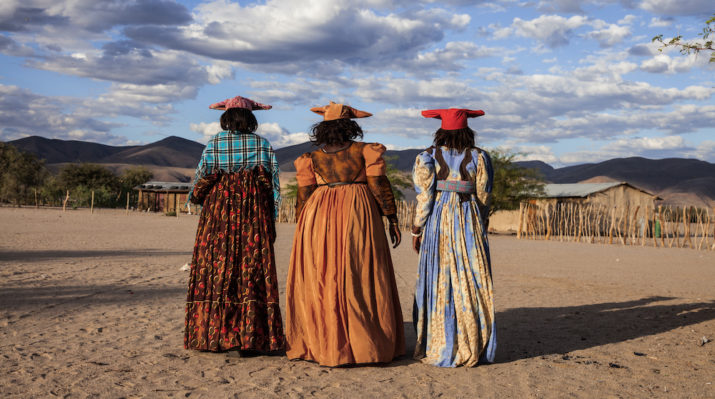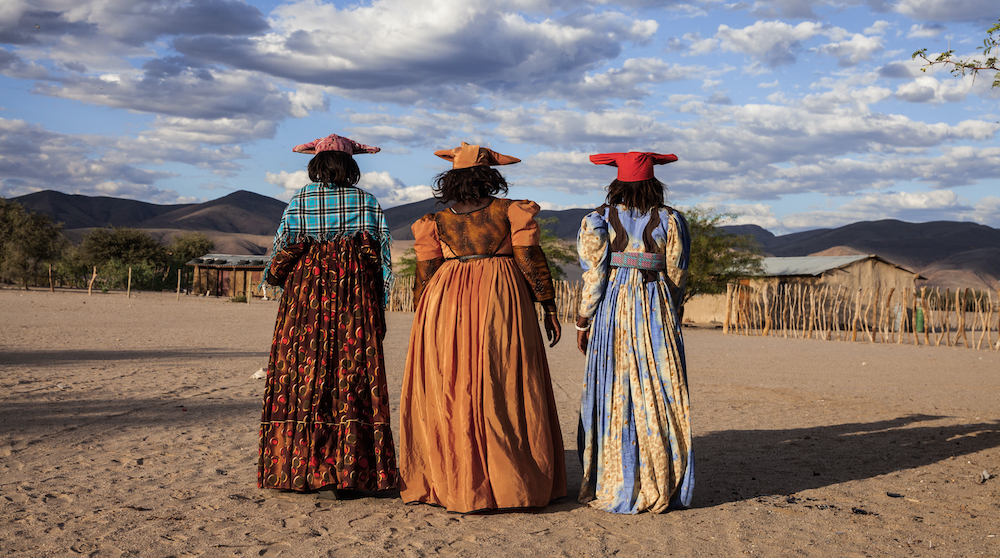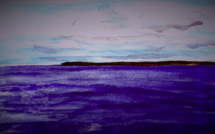

This is part of our special feature on European Art, Culture, and Politics.
Since gaining independence in 1990, Namibia has engaged in a process of seeking reparations from the German government, requesting compensation for the material damages and loss of life that incurred during Germany’s colonial rule in German South West Africa from 1884 to 1915. It has lobbied for formal financial restitution in a number of different ways, most recently through an unsuccessful, but highly publicized, class-action suit brought against the German government in 2019—a case that was conducted, and subsequently dismissed, in a US District court in New York.[1] In addition to these ongoing demands for financial recompense, the Namibian government has been looking for other types of concession from Germany as well. Namibia has repeatedly demanded a formal state apology from the German government, seeking accountability for Germany’s criminal colonial conduct in German South West Africa and an admission of historical guilt for the violence perpetrated there.
Although now chronologically removed by more than a century, the legacies of Germany’s short-lived colonial rule persist in everyday Namibian life, decidedly shaping aspects of the country’s cultural and political memory and affecting decisions pertaining to land reform, aid and economic development. Bilateral relations between Germany and Namibia have suffered as a result of Germany’s unwillingness to acknowledge its past colonial transgressions, making it difficult for both countries to engage in a meaningful diplomatic process of reparation and reconciliation. A central point of contention is formal state recognition of the impact the Herero Nama Wars had—and continues to have— on Namibian society. Identified by scholars as the forgotten genocide of the twentieth century, this conflict occurred between 1904 and 1908 and claimed more than 100000 indigenous lives.[2] Organized as a systematic and government-sanctioned extermination campaign that sought to eliminate opposition to German settler strategies in German South West Africa, these wars resulted in the creation of internment camps, forced relocations of survivors and a complete destruction of the traditional means of life and social structure for these indigenous populations, particularly the Herero and Nama people. This violence has been well documented and studied by historians, many of whom have linked this conflict directly to subsequent impunities perpetrated by the German government during National Socialism.[3] They cite this colonial warfare as an important historical precursor to later developments in Germany, thereby drawing a trajectory between these two forms of state violence and noting in particular the tolerance with which (on both occasions) the German public regarded these events of forceful transgression on part of their government.
Despite the overwhelming historical evidence that exists as to the culpability of the German imperial army in committing these colonial crimes, successive German governments have been slow, if not reluctant, to recognize this aggression in Namibia as an act of genocide. It is only in 2015, a full 111 years after the conflict had occurred, that the German parliament designated the Nama Herero Wars as genocide. It is important to stress that it made this key pronouncement rather inadvertently, and as a joint political measure, while recognizing other historical massacres. This German recognition of the Namibian genocide occurred thus in a rather happenstance manner in both its genesis and execution. As historian Henning Melber explains, the German government was in the process of recognizing the centenary anniversary of the Ottoman Armenian killings in 1915 and had already conclusively voted to declare those national massacres a form of genocide. This vote elicited criticism from the Turkish government, which queried the authority of the German government to make such announcements in view of its own undeclared colonial crimes, thus directly accusing Germany of hypocrisy and selective historical memory.[4] It is only through the process of addressing these criticisms, which quickly spread through the international and national press, that Germany finally pronounced its own colonial killings in German South West Africa as an act of genocide.
The belated recognition of the Namibian atrocities as genocide is particularly unacceptable, as there has been a history of concerted public efforts to designate this violence as systematic and intentional mass murder. There have been many reputable studies conducted that have qualified this conflict as genocide. Most significantly, in 1985 the UN Sub-Commission on Prevention of Discrimination and Protection of Minorities published the so-called Whitaker report that unequivocally termed the colonial violence in Namibia as an act of genocide.[5] Drawing on the 1948 United Nation definition of genocide, the Whitaker report expanded the application of the word genocide past the Nazi crimes committed during World War II, using this particular term to describe a set number of other large-scale global massacres. The report included the 1904 German massacre of the Herero people on its list of cited historical genocides. This transnational political document had, however, little impact on formal German government policies at the time and did not lead to substantive changes in terms of its official state narrative regarding German colonial rule in Namibia. Advocacy for formal, government recognition of the Namibian genocide continued to take place at the local level as well, but with similarly little effect. For example, in 2015 the Berlin-based alliance Völkermord verjährt nicht launched a starkly worded petition to the German government, demanding that it recognize its colonial massacres in German South West Africa as genocide.[6] The petition pressed the German government to engage in a dialogue with descendants of the victims of the genocide and to commit to a transparent process of reconciliation that would secure forgiveness from the current Namibian government.
The 2015 parliamentary recognition of the genocide committed in German South West Africa was, moreover, not accompanied by a formal government apology, nor did it contain a clear strategy regarding compensation for those affected. Instead, this parliamentary admission merely initiated another stage of genocide negotiations between Germany and Namibia, facilitating a discussion of these difficult historical events at the government level. These negotiations continue until this day. Chronologically speaking, the matter of issuing an unambiguous state apology has been a frustrating and rather drawn-out process for the Namibian people that began at the centenary commemorations of the Nama Herero War in Okakarara in 2004. At that event the then German Minister for Economic Cooperation and Development Heidemarie Wieczorek-Zeul, gave a speech and, seemingly moved by the occasion, veered off political script to deliver a spontaneous apology in which she acknowledged German culpability for the war. She directly acknowledged the suffering that occurred during the Herero Nama Wars and offered sincere regret for trauma and the loss of life that incurred. She stated:
A century ago, the oppressors–blinded by colonialist fervour–became agents of violence, discrimination, racism and annihilation in Germany’s name. The atrocities committed at that time would today be termed genocide – and nowadays a General von Trotha would be prosecuted and convicted. We Germans accept our historical and moral responsibility and the guilt incurred by Germans at that time. And so, in the words of the Lord’s Prayer that we share, I ask you to forgive us our trespasses.[7]
To date, this has been the most thorough apology to date offered by the German government to the Namibian people.
Wieczorek-Zeul’s gesture of reconciliation was regarded by many as a turning point in the history of bilateral relations between Namibia and Germany, as it indicated a resolute public effort to address the colonial crimes committed in German South West Africa.[8] Rather significantly, her speech marked an end to the blanket denialism that had dominated German state narratives in regards to its criminal conduct in Namibia, indicating a change in perspective of this history and a possible admission of the state’s moral responsibility for its colonial past. The speech brought considerable international attention to the genocide itself, educating the public to its historic occurrence and ongoing aftermath. On the domestic front, Wieczorek-Zeul’s admission spurred intense and immediate German economic investment in Namibia, most obviously through the somewhat misguided German Special Initiative that began in 2006 and ended in 2017.[9] The 2004 apology also initiated a decisive and steady shift in public perception of the Namibia atrocities, compelling individual German citizens to consider this national violence as a genuine injustice against the Namibian people. In 2007, descendants of Lothar von Trotta, the general who issued the 1904 extermination order against the Herero people, travelled to Namibia to offer a private family apology. A series of important symbolic repatriations also took place in the wake of Wieczorek-Zeul’s speech. In 2011, after much negotiation, twenty human skulls were returned to Namibia from Berlin’s Charité hospital in a public ceremony. The skulls derived from victims of the genocide and had been shipped to Germany during and after the war for race research purposes. In 2014, 2018, and 2019 there were additional returns of human remains to Namibia, with accompanying ceremonies that were attended by dignitaries from both countries.[10]
These repatriations of human remains were highly-publicized events that were covered by and discussed in the media, and this attention helped further propagate the quest of the Namibian government for reparations. Other gestures of reconciliation have taken place in recent years in Germany. A number of pillaged cultural artefacts have been returned to Namibia by various state museums, an undertaking that marks an increased socio-institutional awareness of the importance of decolonizing and restituting these items to their country of origin. In 2019, the Linden Museum in Stuttgart thus returned personal items belonging to Hendrick Witbooi, the legendary Nama leader, which had been stolen from his home during an attack by the German army in 1893. The return of these heirloom items, a Bible and his whip, was a deeply emotional event for both the Witbooi family and the state, and their very public return to Namibia was seen as key gesture of reconciliation on part of Germany and especially on part of the State of Baden Württemberg.[11] The highly-emotional, three-day ceremony that took place upon the return of these items to Namibia highlighted the vital heritage value these items continue to have for the local Nama population, and the role such objects play in shaping local cultures of identity and belonging. The status of other individual colonial museum objects, taken from German South West Africa and currently housed in institutions throughout Germany, continues to be reassessed by cultural authorities in both countries. In 2019, a strong example was made by the German Historical Museum in Berlin, whose staff, upon request, unanimously agreed to return a key item of their permanent collection to Namibia, publicly noting its institutional inappropriateness to keep it.[12] The Stone Cross of Cape Cross, a fifteenth-century territorial marker that used to stand on Namibia’s coast has been marked for imminent return to Namibia.
Within Namibia itself, the national commemorative culture has also been changing to reflect a staunch anti-colonial attitude and to mark a history of anti-colonial resistance. The memorial landscape in Windhoek is a good example of this. In 2014, the towering Namibian Independence Memorial Museum opened to the public, in which the Herero Nama genocide is presented as an important part of official state history and formally explained through a curated exhibit. The physical location of the museum is directly connected to the perpetration of genocide. Overlooking the city, the museum was, namely, built on the unmarked site of a former wartime concentration camp, reclaiming, as it were, this territory for decisive and clear anti-colonial commemorative purpose. The building of the museum significantly altered the colonial urban layout of Windhoek, breaking up a symbolic triad of structures built by the German colonial government to reinforce their presence in the country: the Alte Feste, Christuskirche and the so-called Reiterdenkmal. The relocation of the Reiterdenkmal in Windhoek is particularly interesting. Erected in 1912 by German settlers, it was a “triumphalist” monument celebrating German military victory in the Nama Herero Wars.[13] Despite the change of colonial regime in 1915, the statue was not removed from this prime location, and, in fact, became a type of mascot for the city, appearing on stickers, posters, beer labels, etc. It was eventually relocated from its original location to accommodate the building of the Independence Museum. In 2013, the statue was finally completely removed from the urban landscape and is now hidden from public view, marking the end of this particular type of military remembrance in Windhoek.
In view of these developments, and the decade-long, well-documented history demanding commensurate state recognition for the colonial genocide committed in Namibia, it is surprising to learn of the type of demands made by the German government in recent negotiations. The German government’s negotiation team, led by politician Ruprecht Polenz, a member of the Christian Democratic Union party, has steadfastly maintained that the discussions held are primarily “political-moral” in nature and therefore decidedly not subject to legal investigation and judicially mandated financial compensation.[14] This rules out the possibility of monetary recompense now, while also precluding the possibility of making fiscal demands in the future. More alarmingly, the German negotiating team has been seemingly reluctant to engage with a nomenclature that would appropriately designate the violence of the war as a matter of genocide, avoiding the genocide designation as a suitable description for what happened in Namibia between 1904 and 1908. As Henning Melber explains, the intention of the German negotiating team is to modify the terminology that is in current use to describe the German colonial violence in Namibia, “suggesting in tendency to revert the terminology from ‘genocide’ to ‘atrocities.’”[15] The German Federal Foreign Office has explained the government’s disagreement with the genocide designation as a matter of historic linguistic pedantry, citing the unique relevance that word bears for the Holocaust, and claiming that the terminology of German colonial misconduct must appropriately reflect its own historical context.[16]
This diplomatic linguistic wrangling is troublesome for several different reasons. Foremost, once set and agreed upon, the language of the negotiations will be used to write the definitive historical narrative of Germany’s colonial involvement in Namibia and this hegemonic narrative will, in turn, shape both countries’ collective memory. By avoiding the application of apposite terminology to describe what transpired in German South West Africa during its colonial regime, the German government is interfering with an accurate preservation of the truth, thereby manipulating future interpretations of these historical events. This interference, which is explicit and unapologetic in nature, clearly affects more than contemporary politics alone, it determines the very process of memorialization with which we should consider the Namibian genocide, altering how we reflect on—and ultimately comprehend—these very violent events of the past.
Renata Schellenberg is associate professor of German at Mount Allison University, Canada. She has published widely on print and material culture in Germanophone Europe. More recently, her work has focused on commemorative practices and post-conflict societies, including a monograph on postwar Croatia. She is the recipient of a national funding award (SSHRC) to explore commemorative practices in postcolonial Namibia.
References:
[1] Jonathan Stempel, “Lawsuit against Germany over Namibian genocide is dismissed in New York,” Reuters, March 6, 2019. http://www.reuters.com/article/us-namibia-genocide-germany/lawsuit-against-germany-over-namibian-genocide-is-dismissed-new-york-idUSKCN1QN2SQ
[2] David Olusoga and Casper W. Erichsen, The Kaiser’s Holocaust: Germany’s Forgotten Genocide and the Colonial Roots of Nazism, (Faber and Faber, London, 2011).
[3] For an early (and key) study on this subject, see Jürgen Zimmerer, “The birth of the Ostland out of the spirit of colonialism: a postcolonial perspective on the Nazi policy of conquest and extermination,” Patterns of Prejudice 39, no. 2 (2005): 197-219.
[4] Henning Melber, “Genocide Matters – Negotiating a Namibian-German Past in the Present,” Stichproben. Wiener Zeitschrift für kritische Afrikastudien 33, no. 17 (2017): 1-24 (13).
[5] Benjamin C.G. Whitaker, Revised and updated report on the question of the prevention and punishment of the crime of genocide (Geneva: UN, 1985). http://www/digitallibrary.un.org/record/108352?In=en
[6] Appeal Genocide is Genocide! (Berlin: Bündnis “Völkermord verjährt nicht”, 2015).
[7] Heidemarie Wieczorek-Zeul, ‘Speech at the the commemorations of the 100th anniversary of the suppression of the Herero Uprising” (Okakarara, Namibia, August 14, 2004), Embassy of the Federal Republic of Germany Windhoek, http://www.windhuk.diplo.de/Vetretung/windhuk/en/03/Commemorative_Years_2004_2005/Seite_Speech_2004-08-14_BMZ.html.
[8] Karie L. Morgan, “Remembering against the nation-state: Hereros’ pursuit of restorative justice,” Time & Society 21, no.1 (2012): 21-38 (32).
[9] For more information, see http://www.ngsip.org/who-we-are.
[10] Andreas Winkelmann and Holger Stoecker, “Rückgabe von Schädeln und Skeletten an Namibia: Überreste einer fragwürdigen “Rasseforschung”, Deutsches Ärtzteblatt 111, no. 18 (2014): 792-3, https://www.aerzteblatt.de/int/article.asp?id=159510. Accessed February 28, 2020.
[11] Brigitte Weidlich, “Witbooi Bible returned to Namibia,” Gondwana’s Newsroom, March 6, 2019, http://www.gondwana-collection.com/news/article/2019/03/06/witbooi-bible-returned-to-namibia.
[12] Birgit Rieger, “Die Säule von Cape Cross geht zurück nach Namibia,” Der Tagesspiegel, May 17, 2019. http://www.tagesspiegel.de/kultur/rueckgabe-von-kolonialobjekt-die-saeule-von-cape-cross-geht-zurueck-nach-namibia/24355024.html
[13] Heike Becker, “Changing Urbanscapes: Colonial and Postcolonial Monuments in Windhoek,” Nordic Journal of African Studies 27, no. 1 (2018): 1-17 (5).
[14] For more on this, see Daniel Pelz, “German apology about colonial-era genocide in Namibia likely to be delayed,” Deutsche Welle, August 1, 2017. http://www.dw.com/en/german-apology-about-colonial-era-genocide-in-namibia-likely-to-be-delayed/a-39920073.
[15] Henning Melber, “Addressing the genocide in Namibia,” Africa is a Country, March 14, 2018. http://www.africaisacountry.com/2018/03/addressing-genocide-namibia
[16] “Addressing Germany and Namibia’s past and looking to the future,” Federal Foreign Office, July 1, 2019. http://www/auswaertiges-amt.de/en/aussenpolitik/regionaleschwerpunkte/afrika/-/1991702
Photo: Herero people | Shutterstock
Published on April 28, 2020.




